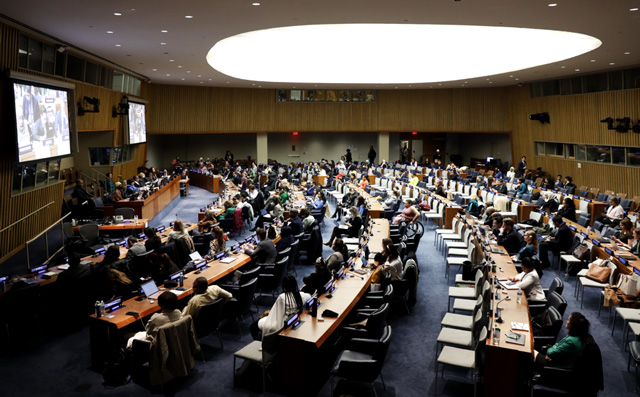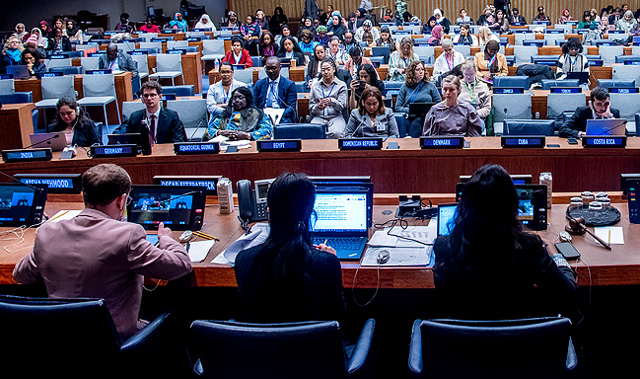Fighting Gender Disparities In a Digital Age

Photo: UN Women/Ryan Brown
By Aminata Gueye
It’s exactly the scene one would imagine when they hear, “The United Nations.” Japanese, Wolof, German, French, English, and Arabic chatter filled the atmosphere. All carried an energy of excitement and anticipation. At the main entrance, men and women were dressed in their traditional cultural outfits. The warm orange fabric covering Tibetan monks with clean-shaven heads, the Boubous and Ankara wax print dresses on West African women, and Indian saris glittering with silver beads floated from one corridor to the next. It’s an event people travel all over the world to attend, because all over the world, countries are united by gender disparities that limit women and girls.
On March 6, the 67th Commission on the Status of Women (CSW) convened to explore the theme, “Innovation and technological change, and education in the digital age for achieving gender equality and the empowerment of all women and girls.” CSW is the United Nation’s largest annual meeting on women’s rights.
Member states, NGOs, youth delegates, and ministers addressed new issues for women and girls in our increasingly online world. Branching from this year’s expansive theme, issues like the digital divide, gender-based violence, rural women’s rights, online harassment, education and lack of representation were covered over the two weeks.
According to UNWomen.org, this year’s CSW had a significant turnout, “In the first fully in-person session following three years of the COVID-19 pandemic, CSW67 registered very high numbers with more than 7,000 participants, including 4 heads of state and government and 116 ministers, 205 side events on UN premises, and about 700 NGO parallel events. “

Secretary General Antonio Guterres. Photo: UN Photo/Manuel Elías
Secretary-General Antonio Guterres opened the session, promoting gender equality in the development of technology and STEM careers. He provided three action points which he said would help equalize power between men and women in an increasingly technological world. First, that countries must increase education, income, and employment for women and girls, particularly in the Global South. Second, that countries should encourage women and girls to participate and lead in science and technology, from governments to board rooms and classrooms. “Third,” said Guterres, “we must create a safe digital environment for women and girls.”
During the interactive dialogue with youth representatives, the youth delegate of Japan gave an impassioned statement, describing the experiences of her peers as they walked the intimidating halls of the United Nations. It is a testament to the discussions over disparities and the need for representation when even within the UN, these concerns are being voiced.
The general discussion concluded on March 15. The representative of the United States, Ambassador Linda Thomas-Greenfield, spoke on the situation in Afghanistan, where the Taliban have banned women from working with NGOs, limited women’s participation in public life and the economy, and prevented women and girls from attending secondary schools and universities. Throughout CSW, member states voiced their support for Ukraine, but especially the women of Ukraine, who face higher levels of violence and human rights violations by the Russian Federation.
Ambassador Linda Thomas-Greenfield highlighted the trafficking and gender-based violence women in Ukraine experience from Russian forces. She also reported on women’s harassment online, stating that 8 in 10 women and girls have experienced online harassment and abuse. She concluded her statement by describing the United States task force that has established programs and research centers to overcome digital violence.

Photo: UN Women/Catianne Tijerin
By the end of CSW, people from differing cultural and socio-economic backgrounds tackled the most contentious conflicts happening around the globe. They turned a magnifying glass towards the forgotten and vulnerable, a multilateral, unified front to diminish gender discrimination.
Saved under Featured Slide, News
